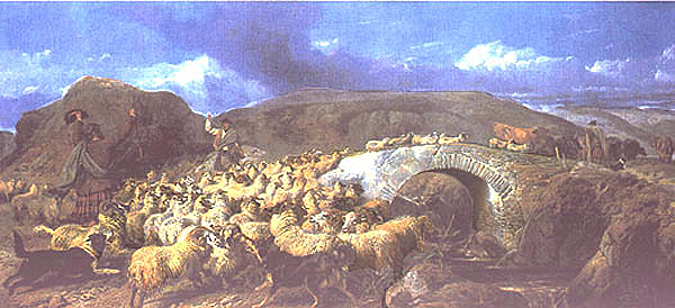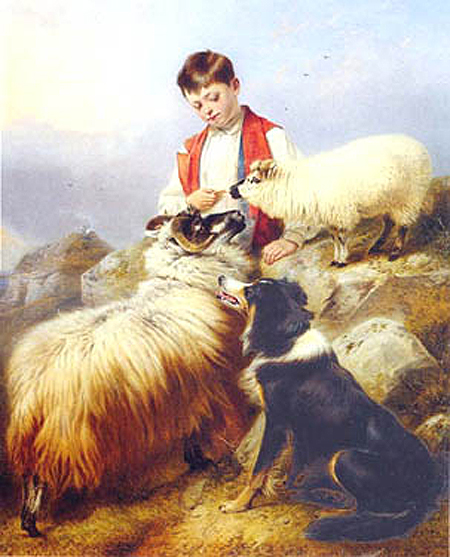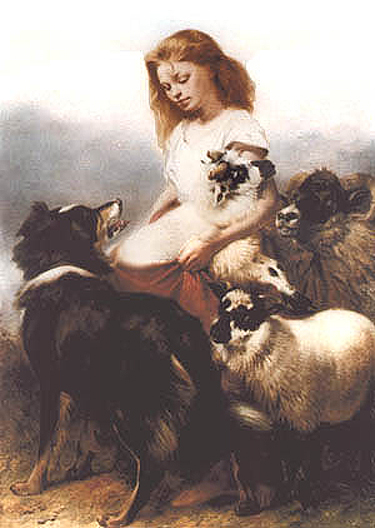
Border Collie Rescue - On Line - Origins, Name and Purpose

Origins, Name and PurposeOrigins - The breed has been developed over hundreds of years by Shepherds who were seeking to improve the working abilities of the traditional breeds they had been using. There are very few historic images of Border Collies but one artist, Charles Ansell, born in Paddington, Middlesex in 1794 and died in Brighton, Sussex in 1881 had an obsession with Scotland and its shepherds and sheep. In fact their whole lifestyle.  He painted many pictures to capture them at work and in leisure and in
many of these there was a Border Collie doing exactly what they are designed to do.
He painted many pictures to capture them at work and in leisure and in
many of these there was a Border Collie doing exactly what they are designed to do.On the left is 'Turning the Drove which was painted in 1851. Two dogs are in the bottom left corner of the picture and there is at least one more over the bridge with a shepherd. Below, right, is 'Herd and Lassie" (Lassie being the girl, not the dog!)
Ansell's pictures show the Border Collie wearing the same coat as they
wear today and doing the same job in the early to mid 19th century but
there are earlier references.
In the days of the Border Rievers there are stories of black and white dogs trained to herd stolen stock from a raid back to a secure place on their own land where the thieves could collect the stock once the coast was clear. It was a lawless period in country on either side of the Border that had been ravaged and decimated by wars between England and Scotland. Rieving was an organised and widespread activity. There were big families involved, Dukes and Earls leading them with smaller less powerful families bound to them by oath of loyalty - which didn't mean much on some occasions. The dogs they used were described as black all over other than having white tips to their tails and white chests. Their work took place on moonlit nights. You may have heard of the expression "A Rievers Moon". Horseback raids took place and the dogs kept up until sufficient stock had been stolen and gathered and then were send off home with it while the raiders went on after more. In the low light the white on the dogs chests could be seen by the livestock in front of them but not from anyone following behind. While working, tails were kept down and anyone pursuing would not see the white on the tips. If you watch Border Collies working today you will see the tail held low when the dog is concentrating! If the owners of the stolen livestock caught up, the dogs could fade off into the night and live to herd another day. If their owner called them by name they raised their tails and the white tips could be seen in the darkness helping the raisers locate them. The Rievers were active for around 300 years up to 1603 when James of Scotland succeeded to the English throne and the two counties united.  Landowners threw tenant farmers out on their ears in order to dedicate the land to growing wool. Shepherding had always been a respected trade and now good shepherds were in great demand, as were their dogs. Various breeds were use in different parts of the country on different terrains they were best suited to. Close work with such large flocks became more difficult. many herding breeds did their work by barking and moving quickly behind the sheep which in large flocks often led to a scattering and the need to gather in again. These problems lead to to great deal of interest in any dogs with 'eye' who could control stock simply by staring and moving quietly from side to side to get them moving in the required direction. Eye is one of the best qualities of the Border Collie and it was developed by selective breeding which took shepherding to a whole new dimension. Sheepdog trials are recorded as early as the 1870's and The International Sheepdog Society was founded in 1906 to organise and co-ordinate these rather localised competitions and to form and hold a stud book for the dogs competing in order to improve the breed and the management of livestock. This is when Border Collie Bloodlines became dedicated and the wide and varied regional 'types' that had sprung up started to become more unified. Auld Hemp, a dog belonging to Adam Telfer from Northumberland is reckoned to be the progenitor of the breed we know today. He lived between 1893 and 1901 and although he was not No 1 in the ISDS stud book he was considered to be the best sheepdog alive at the time and nearly all Border Collies alive today owe that to Auld Hemp. He was a quiet worker and was never formally trained. Telfer is reputed to have said "he flashed like a meteor across the sheepdog horizon. There never was such an outstanding personality" and Eric Halsall, shepherd, author and commentator on One Man and His Dog said "none who saw him ever forgot him...Almost faultless in work...he was born with such knowledge of his craft that he never required training and went to his work naturally." Auld Hemp is not the most famous or prolific Border Collie. That accolade goes to Wiston Cap who belonged to John Richardson who had bought him at 6 weeks old in 1963. In the 1965 International Sheepdog Trials, Wiston Cap became supreme champion at less than two years old and was the most popular stud the breed ever had. Many of the pups he sired went on to become Trials champions, including 3 International Trials Champions. It is said that Wiston Cap's genes are in every Border Collie alive today.  Selective breeding - that is to say breeding from the best and preventing the rest - cemented the traits and instincts shepherds wanted to see in their dogs. (This is something we all should take more seriously these days). What came out of this, and what we now have, is acknowledged as the best Working Sheepdog breed in the world . Name The prefix 'Border' refers to the Borders of England and Scotland where the breed - in its present form - originated. The word 'Collie' is an old Scottish term and means 'useful'. Therefore a 'Collie Dog' is a 'useful dog'. We can have a 'collie tool' - a favourite and useful implement that does the job it was intended to do, and does it well. Put the two together and we have a name that simply means - 'Useful dog from the Borders (Region)'. The name Border Collie was not used until after 1906 when the first secretary of the International Sheep Dog Society, James Reid, is credited with having created it. Purpose - This breed has been created to work stock, originally sheep, but variations were bred that were better suited to work and herd other species of domestic animals. The use of selective breeding as referred to in Origins, above, has re-enforced the characteristics best suited to this form of activity. It took many, many, generations to cement the necessary traits and mold the breeds natural instincts. These are not going to disappear quickly.  Herding
and working livestock was the sole purpose behind the Border Collie until very
recently. Herding
and working livestock was the sole purpose behind the Border Collie until very
recently.We are now have these instincts and characteristics built into the breed, but they do make the breed what it is, and without them it would not be the same. We can remove or dilute these instincts by applying selective breeding until we have variations that have other characteristics. This will take time and perhaps as many generations to breed the instinct out as as it took to breed it in. There are some breeders who are attempting to create bloodlines that have less herding instinct and are more 'domesticated' and 'user friendly', but this is not going to be easy to achieve. We do not have these 'pet' variations yet. One of the obstacles to achieving this is the need to inject DNA from the wide working line pool into the domestic line pool to prevent inbreeding and the decreasing gene pool causing inherited disabilities, deformities and behavioural issues. Some of the most well know domestic blood lines have occasionally put out litters with sever temperament problems . We've had a few through our hands Don't be fooled - phrases like "this breed is intelligent and easy to train and handle" and the old chestnut "will make a good working dog or pet" are phrases designed to sell dogs and each statement contradicts itself. The last word in this section is another picture by Charles Ansell, above, entitled "Spring in the Highlands'. Nice looking Tri-colour. |
If you are interested in adopting a Border Collie from us,
please do not write to us or email us - we want to speak to you before we start the process.
Please phone us during office hours. Details here.
Calls to our office and mobile will only be answered during our office hours






















